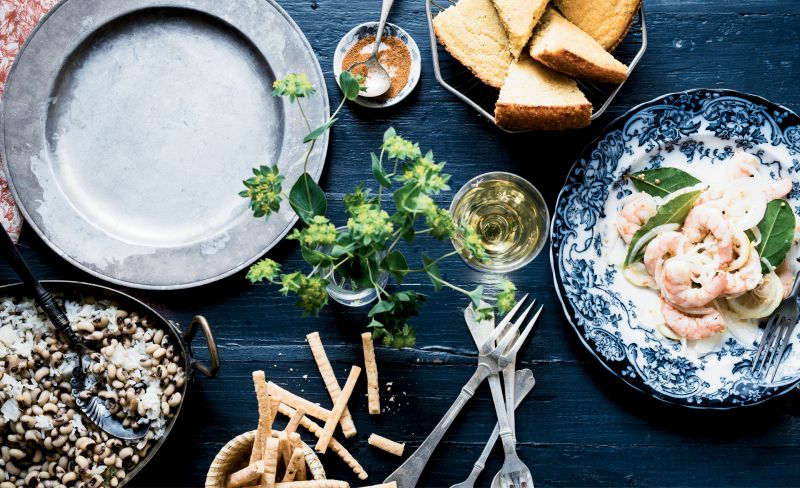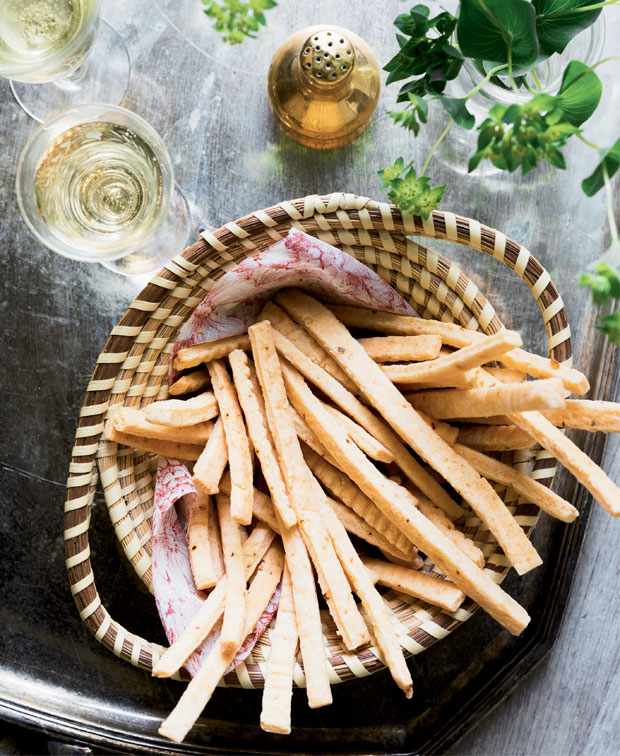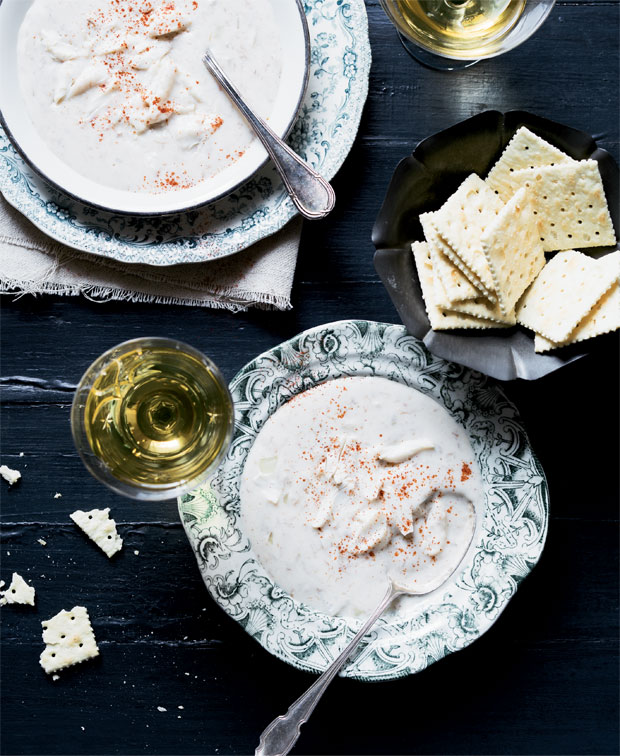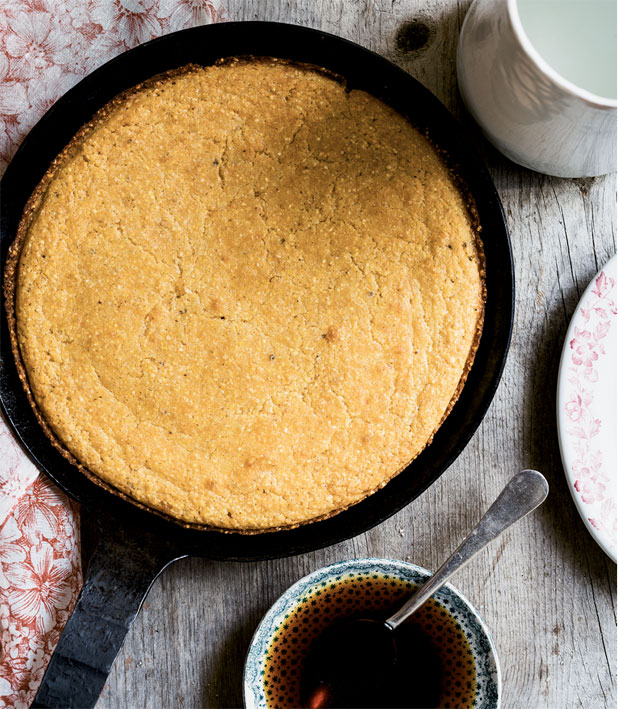
1. Boiled Peanuts
No other handwritten roadside sign brings us to such a screeching halt. Many non-Southerners are startled at first by our love for damp peanuts so tender they eat like beans (peanuts are legumes, after all). But once you’ve acquired the taste for this hot, salty, messy, slow-simmered snack, it’s nearly impossible to put down the bag. Click here for recipe.
2. Henry’s Cheese Spread
Many decades ago, long before Charleston’s restaurant scene exploded, a big night out involved Henry’s on Market Street, where white-jacketed waiters swooped in with trays of iced crudité, including this malty cheese spread that’s so addictive, it’s tempting to eat it by the spoonful. Try Matt Lee and Ted Lee’s adaptation of the spread (published in their 2012 The Lee Bros. Charleston Kitchen), and it’ll quickly become a party favorite. Click here for recipe.
3. Benne Wafers
Proust’s madeleine has nothing on Charleston’s benne wafers in the taste-memory department. We’ve been baking these paper-thin, chewy-crisp, salty-sweet, buttery-nutty cookies for centuries, using toasted benne seeds introduced by African slaves during Colonial times (“benne” is Bantu for “sesame”). Hugely popular as souvenirs, benne wafers are said to bring good luck to those who eat them. Click here for recipe.

4. Cheese Straws
Crispy, salty, spicy, cheesy, these baked crunchy munchies are ubiquitous at downtown cocktail parties and tailgates. We can’t say cheese straws are unique to Charleston (the small country of Guyana asserts a claim), yet somehow they’ve marched into our tradition of Southern hospitality. Many locals keep a frozen log of cheese dough at the ready to slice and bake when company comes.Click here for recipe.
5. Pimiento Cheese
Pronounced fluidly “pimenta-cheese” and nicknamed “Southern caviar,” this signature piquant-creamy spread nestles into crustless finger sandwiches, tops burgers, and gussies up fried green tomatoes. Most of us just hoover it up on crackers, especially Nathalie Dupree’s recipe. Click here for recipe.
6. Jerusalem Artichoke Relish
Truth be told, Jerusalem artichokes are neither from Jerusalem nor are they artichokes. These small, native sunchoke tubers with a water chestnut-like consistency slice, dice, and pickle beautifully. Typically served over cream cheese as an hors d’oeuvre, a little artichoke relish can also brighten any plate. Buy Mrs. Sassard’s by the jar (it’s truly delicious) or make your own with John Martin Taylor’s tried-and-true recipe. Click here for recipe.
7. Ice-Box Pickles
A sweet-tart way to preserve and punch up the humble cucumber, ice-box pickles make a cool, crunchy summertime snack or delicious burger topping. If you’re willing to brave the line at Jestine’s Kitchen, you can enjoy these finely sliced beauties alongside corn bread. But there’s really no reason not to make them yourself and tweak them to your liking with garlic, herbs, or hot peppers. Click here for recipe.

8. Spiced Pickled Shrimp
Many local dishes feature the Lowcountry’s ubiquitous crustacean, but pickled shrimp has been a longtime cocktail-party staple for good reason—it’s delicious and easy. Prepare a batch a day in advance, serve over ice with toothpicks, et voilà—a light and bright yet complex and crave-worthy appetizer. Make Lavinia Huguenin’s mid-century receipt or mix it up with your favorite flavors. Click here for recipe.
9. Pickled Okra
Heat-loving okra falls into the category of bigger-is-not-better. You want to pluck the pod while still young and tender about the size of your pointing finger. Pickling the veggie with varying degrees of heat makes it available year-round, perfect for cocktail party munching or garnishing a Bloody Mary. Click here for recipe.
10. Charleston Okra Soup
Matt Lee and Ted Lee have asked hundreds of chefs why Charlestonians have historically flavored okra soup with rich, dark, bone marrow. No one has an answer, apart from, “Because it tastes good.” Head up to Bertha’s Kitchen for an intensely soulful version of this silky, meaty, tomato-based staple, or try your hand at the Lee Bros.’ recipe. Click here for recipe.
11. Shrimp & Grits
Many restaurants riff on this beloved combo of sautéed shrimp over “hominy” (as it used to be called). ACME Lowcountry Kitchen, for example, offers jerk shrimp over coconut grits with pineapple salsa. Old-schoolers keep it simple, allowing fresh, local shrimp and quality, stone-ground grits (like Geechee Boy’s or Anson Mills’) to speak for themselves. Nathalie Dupree, who literally wrote the book on the subject with Charleston food editor Marion Sullivan (Nathalie Dupree’s Shrimp & Grits Cookbook), recounted its humble beginnings as a recipe in Two Hundred Years of Charleston Cooking (1930). We suggest you prepare that simple “Shrimps & Hominy,” then make it your own. Click here for recipe.
12. Shrimp Paste
Don’t be fooled by shrimp pastes laden with mayonnaise or cream cheese. Charlestonians have been grinding shrimp into smooth pastes for centuries. Served cold or as a warm mousse, shrimp paste relies on little more than butter, a dash of spices, perhaps a hint of sherry. Savor it on crackers, thin toast, or finger sandwiches (crusts removed, of course). Click here for recipe.
13. Shrimp Pie
This popular casserole-style dish dates back to the 19th century, and two versions were included in Sarah Rutledge’s 1847 cookbook The Carolina Housewife. As household help typically had Sunday afternoons off, the cook would assemble this savory “pie,”and the lady of the house would simply slip it into the oven before supper. Rutledge’s “Baked Shrimps & Tomatoes”calls for layers of crustaceans, stewed tomatoes, spices, and rich buttery goodness that marry well in the fridge before baking. Just watch the salt, as the shrimp will add natural brine. Click here for recipe.

14. She-Crab Soup
An elegant, lightly creamy bisque loaded with chunks of blue-crab meat and spiked with a touch of dry sherry, she-crab soup is credited to William Deas, the cook for Mayor Goodwyn Rhett who first prepared it for President William Taft. Astute chefs know to seek out female crabs with faint orange shells that signify the presence of precious, briny roe within. Click here for recipe.
15. Cream Oysters
Let’s face it: anything that calls for two cups of heavy cream promises to be delicious. The natural liquor from the oysters themselves thins out this classic preparation. Published in 1847’s The Carolina Housewife by venerable Charleston lady Sarah Rutledge, cream oysters are ideal when ladled over puff pastry. Click here for recipe.
16. Roasted Oysters
No cool-weather outdoor gathering is complete without a bushel of local oysters, roaring fire, long table, cooler of beer, and ample oyster knives. The bivalves are best roasted on a flat surface for even cooking, steamed under cover of a damp burlap sack, and cooked just to the point of opening (overcooking will dry them out like raisins). Grab a knife, pop the hinge, and slurp ’em down. Click here for tips on how to throw an oyster roast.
17. Oyster Dressing
Thanksgiving dressings often celebrate regional treasures. Take, for example, East Texas’ venison dressing, Tennessee’s sausage dressing, or Georgia’s pecan dressing. In the Holy City, we turn to corn bread and oysters to complement our bird. Michelle Weaver of Charleston Grill offers her decadent version with stone-ground white cornmeal, Parmesan, and three dozen oysters. Click here for recipe.
18. Fried Oysters
Biting into a perfectly fried oyster is a voyage of discovery: The delicately crisp casing gives way to the creamy, mineral-rich prize within. Master that fry technique, then perch them atop deviled eggs like Macintosh chef Jeremiah Bacon does, and you have a marriage of Southern favorites made in heaven. Click here for recipe.
19. Shad Roe
The running of American shad, the largest herring, is a Lowcountry rite of spring, with local chefs and old-school cooks alike seeking out the prized sacks of roe from the dark-fleshed, bony fish. While it’s been ages since the Eastern seaboard was lined with seasonal herring shacks—they were shuttered one by one as river dams impinged on the fish’s annual migration—Crosby’s Seafood still manages to get a hold of shad and its roe. Cook them in the traditional manner (wrapped in bacon, pan-fried, and served over grits) for a rich and creamy Lowcountry delicacy. Click here for recipe.
20. Crab Cakes
We don’t credit our Colonial ancestors with much (British food gets such a bad rap), but we must admit that crab patties, or croquettes, were a great idea—we just spiced them up a bit. Most agree that the best crab cakes feature the meat itself with very little binder, are lightly breaded (if at all), and fried to a golden brown. Click here for recipe.
21. Deviled crab
Crabmeat hand-mixed with seasonings, nestled back into the open shell from whence it came, topped with buttered bread crumbs, and baked to glory—for many years, the former Henry’s on Market Street was the place to go for this special dish. These days, you can find deviled crab at The Wreck on Shem Creek, made up by none other than Skipper Shaffer, great-grandson of Henry’s founder. Health codes red-flag the actual shells, so they’re served up in aluminum ramekins. Not quite the same, but still delicious. Click here for recipe.
22. Fried whiting
Whiting, or southern kingfish, is plentiful on our shores, cruising beneath surfers on Folly and anywhere waves are breaking. It’s common to see anglers load up coolers full of them, destined to be deep fried and served with hot sauce, as has been the traditional preparation, especially among African-American cooks. In their 2012 cookbook The Lee Brothers Charleston Kitchen, Matt and Ted celebrate the sweet, mild flavor of this tasty panfish with a lighter skillet approach. Click here for recipe.
23. Barbecue
The word “barbecue” is said to have been derived from the West Indian “barbacoa,” for the slow-cooking meat over hot coals. Around here, it means pork, usually a whole hog, cooked low and slow, and a long night of tending fire. And while most pitmasters guard their secrets, Jimmy Hagood of BlackJack Barbecue shares a Boston butt grill recipe that even novices can master. When the meat takes on a buttery tenderness, shred it up on slices of Wonder Bread and watch the crowd form. Click here for recipe.
24. Charleston Rice
Most Charlestonians don’t consider a meal complete without rice on the plate. Our city was, after all, built on the wealth of rice exportation. Dedicated members of the Carolina Gold Rice Foundation have worked hard to restore the aromatic antebellum grain to our pantry. Cooked in the traditional Charleston rice steamer, each fluffy and never-sticky grain holds its own and requires little more than butter and a pinch of salt—though gravy is always welcome. Click here for recipe.
25. Pilau
There are as many variations on preparing as there are in pronouncing this antebellum rice-based dish, but locals generally say “purr-LO.”A medium for veggies, seafoods, or meats, it’s basically rice cooked in a rich stock until tender. The toasty layer that forms at the bottom of the pot is part of the charm, so mix it in before serving for a little crunch. Click here for recipe.

26. Frogmore Stew
New Orleans has crawfish boils; we have frogmore stew (named for the little town of Frogmore, down the coast on St. Helena Island). It’s the same principle: seafood, sausage, potatoes, corn, and spices, only we feature shrimp, sometimes throwing in stone crab claws from local waters for good measure. Click here for recipe.
27. Hoppin’ John
A peas-and-rice dish eaten year-round but always on New Year’s Day for good luck, hoppin’ John features the humble field pea (and if you eat it the day after New Year’s, it’s called “skippin’ Jenny”). Petite Sea Island red peas are ideal, as is aromatic Carolina Gold rice for superior flavor and texture. Some insist the peas and rice be cooked together, others say separately and then combined. Charlotte Jenkins, author of Gullah Cuisine: By Land and By Sea, shares her recipe, cooked together with ham hocks, onion, and thyme. Click here for recipe.
28. Red Rice
Not to be confused with Creole dirty rice, red rice is essentially tomato pilau, as John Martin Taylor notes in his seminal Hoppin’ John’s Lowcountry Cooking: Recipes and Ruminations from Charleston & the Carolina Coastal Plain. Sometimes sweetened with a touch of sugar and flavored with diced bacon, salt, and pepper, red rice has been satisfying Lowcountry denizens since well before the Civil War. Click here for recipe.
29. Chicken Bog
Chicken bog is, well, boggy—i.e. moisture-retaining but not soupy (picture the damp floor of a low-lying cypress grove for boggy inspiration). A stick-to-your-ribs rice dish slow simmered in chicken stock and laced with tender shredded meat, Matt and Ted Lee call it “a close cousin to the classic Lowcountry pilau” in their 2006 The Lee Bros. Southern Cookbook. Chef Louis Osteen, who moved to the Lowcountry from Atlanta in 1979, learned his recipe from Dickie Creighton, “a legend in Pawleys Island,”he says. “I’ll never forget the comfort of its warm simplicity.” Click here for recipe.
30. Fried Green Tomatoes
You’ll find fried green tomatoes jazzed up all over town: with pork-belly croutons and feta at Cru Cafe, tomato chutney and country ham at Magnolia’s, comeback sauce and goat cheese at Southerly. No matter the sidekick, these crispy-tart slices are the star. Click here for recipe.
31. Sweet Potato Pone
The ladies who contributed to Charleston Receipts grated their sweet potatoes and sweetened their pone with molasses or dark cane syrup, as did Gullah chefs (from whom the Junior Leaguers probably learned the “sweet tada pone” receipt in the first place). James Beard Award-winning chef Robert Stehling of Charleston’s beloved Hominy Grill sticks to brown sugar and stays true to the citrus-cinnamon signature of this hot, rich dish. Click here for recipe.

32. Corn Bread
A thoroughly New World creation, the once plain hoecakes of cornmeal, fat, and water have evolved across the country with the addition of sugar or molasses, dairy, and leavening agents. Here in Charleston, you can get savory skillet breads with cracklin’ at Husk or sweet cake-like squares at S.N.O.B. If you make your own, be sure to splurge on quality cornmeal such as the coarser, stone-ground varieties available through Anson Mills or Geechee Boy Mill in nearby Edisto. Pitmaster and Food for the Southern Soul owner Jimmy Hagood shares his savory cast-iron skillet corn bread sweetened only by a kiss of cane syrup. Click here for recipe.

33. Fried Okra
In her classic Gullah cookbook, Bittle en’ T’ing’, Maum Chrish’ refers to fried okra as “buckruh ok’ry” (white people’s okra). She insists okra be cooked so tenderly it doesn’t require chewing but acknowledges that some like it fried. Anyone who’s ever eaten raw okra straight off the vine knows how satisfying the crunch can be, and frying is a great way to seal in flavor. Click here for recipe.
34. Succotash
Succotash is as it sounds: a free-form collision of ingredients. But in actuality the word derives from the Naragansett Indian “msickquatash,” translating to “boiled ear of corn.” Sweet corn parties with butter beans or field peas, tons of fresh herbs, garlic, and butter. Any veggies will do, perhaps even a little smoked ham hock or bacon drippings for a Southern charge of flavor. Click here for recipe.
35. Collard Greens
A field of collards is a beautiful sight—bundles of large, dark-green, bitter leaves waiting to be stewed into submission. The process of rendering them takes hours on a stove top (an acquired smell that, like pluff mud, conjures sense of place), usually involving salty pork broth. Cookbook author Charlotte Jenkins learned her recipe from generations of women in her Awendaw-based family. Click here for recipe.

36. Lady Baltimore Cake
Celebrated author of Mrs. Whaley’s Charleston Kitchen, the late Emily “Cheeka” Whaley was a local grande dame of entertaining, though she always considered herself a country girl at heart. She managed to lure the recipe for Lady Baltimore cake from the originator’s granddaughter. (A favorite at the Ladies Exchange, it was made famous by the 1906 novel Lady Baltimore.) A firm white layer cake interspersed with sherry-soaked raisins, nuts, and hard icing, it was highly popular at weddings and birthdays. Click here for recipe.
37. Huguenot Torte
An incredibly sweet confection, somewhere between apple-pecan pie and a spongy blondie, this torte was for years attributed to the Huguenots, who still hold services in French behind their pale-pink church at the corner of Church and Queen (the congregation dates to the 1680s). Food historian John Martin Taylor did the research and busted the myth, however, revealing that a chef at the former Huguenot Tavern sourced an Ozark pudding recipe, tweaked it, and introduced it to Charlestonians in the 1940s as “Huguenot Torte.” It remains one of the city’s most famous desserts. Serve with a generous dollop of unsweetened, freshly whipped cream for a dreamy balance of flavors and textures. Click here for recipe.
38. Coconut cake
A longtime favorite on the Southern dessert table, this layer cake became a Charleston sensation when Peninsula Grill first served its frothy-light, 12-layer version in 1997. Soon, cake lovers across the country began ordering them for a whopping $130 a pop plus shipping costs. Although we can’t share that recipe, the kind folks at Square Onion offer theirs for six layers of true indulgence. If you want to stay true to old Charleston cookbooks, use freshly grated coconut. Click here for recipe.
39. Syllabub
The name alone is worth reviving, yet this old-school Colonial dessert has fallen out of fashion. That needs to change. A delicious end to a full meal, syllabub is a light, airy blend of fortified wine, cream, and lemon. While earlier recipes, notably one from The Carolina Housewife (1847), contained more alcohol, ours has been tamed to suit modern tastes. Click here for recipe.
40. Groundnut Cakes
Culinary sleuth and author Dr. David S. Shields notes that penny groundnut cakes were sought-after confections of peanuts and molasses sold on Charleston street corners and along wharves until health officials put the clamp on vendors in 1918. Brothers Matt and Ted Lee share their recipe for these bronzy, sweet, crispy nuggets. Click here for recipe.